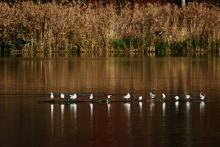
Not all water protection schemes involve protecting the environment from quarrying activity - at Cemex's Attenborough Lakes it was the other way around
Much of the focus on water protection in quarries is rightly on minimising water use and preventing sediment-rich water flowing untreated into watercourses. But for some sites restoration efforts mean that water within quarry operations needs to be sheltered from the outside environment.
The reserve is situated near Nottingham and comprises flooded gravel pits excavated between 1929 and 1967. It was the first reserve established by the Wildlife Trust, which is the UK's largest voluntary organisation dedicated to conserving wildlife habitats and species.
The nature reserve is managed by the Nottinghamshire Wildlife Trust in partnership with Cemex and the open water and islands cover 145ha, providing habitats for many species of wildlife including over 250 species of birds and waterfowl.
The ponds at the nature reserve were flooded in 1972 via connections with the River Erewash, which receives discharges from eight sewage treatment works, and drains a catchment that is heavily urbanised and has a legacy of mining and other industry.
Concern about water quality in the River Erewash led to the isolation of Clifton Pond in 1981 and Church Pond in 1996 from this river source. This resulted in a visible improvement in the water quality in both ponds, and the establishment of a rich aquatic plant flora. In contrast the water quality in the ponds that remained connected to the River Erewash was shown by a survey in the 1990s to be severely degraded. This has been primarily through enrichment with nitrogen and phosphorus from the sewage treatment works and from agricultural land that drains the Erewash Valley.
Following prolonged discussions about a solution, Cemex submitted an application to divert the bulk of the flow in the River Erewash directly to the River Trent and work on this started late last year.
The design of the scheme is based on a comprehensive programme of monitoring water levels and water quality in the lake system, undertaken by Cemex in 2003. This provided a baseline against which to compare the impact of the proposed diversion.
As part of its monitoring network Cemex had a flow meter installed in the River Erewash about 400m upstream of the diversion site. The flow meter works by sending ultrasonic sound pulses alternately between probes mounted on opposite sides of the river and measuring the time difference between the transmitted and received pulses which varies with the flow velocity.
The monitoring data was used to calibrate the hydraulic model and will also be used in assessing the long-term performance of the diversion scheme.
The diversion is to be achieved by constructing an earth embankment between the present mouth of the River Erewash and the northern bank of the River Trent. The embankment will include a six metre wide gap to allow the movement of barges which transport sand and gravel from Cemex's Attenborough Quarry to the processing plant.
In order to minimise the spread of contaminated silt from the Erewash and to assist the passage of barge traffic, Cemex recently suction dredged of a 400m stretch of the navigation channel to the east of the embankment gap.
A new outfall will be constructed to the River Trent incorporating a fish pass. Hydraulic modelling has indicated that over 90% of the flow in the Erewash will be diverted to the Trent and that there will be no increase in the risk of flooding of the lake system. The project is scheduled for completion in autumn 2009.











